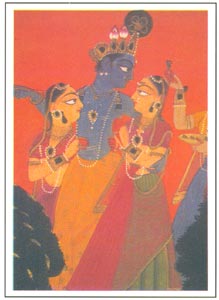 |
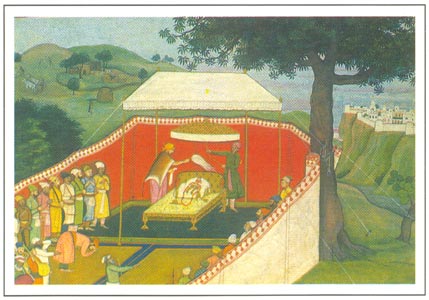 |
|
Krishna dallying with Gopis, Basohli, 1730 A.D., National Museum, New Delhi |
Bharat worshipping Rama Paduka, Guler, circa 1780-85 A.D., National Museum, New Delhi |
|
|
Pahadi Paintings
Pahari miniatures, known for their soft touch, serenity, lyricism, spontaneity, inherent symbolism, superb sense of composition, minute details and a deep feeling for human emotions, denote the miniature paintings rendered around the lower Himalayan hills and the plains of Punjab from the early 17th to mid-19th century. In 1690, Basohli, a hill state on the bank of the river Ravi, was the first to initiate the art of hill region. Later there developed at Guler, Chamba, Mandi and Kangra major and at Garhwal, Hindur, Jammu, Kullu, Bilaspur, Srinagar and in plains of Punjab minor centres of Pahari art. Despite stylistic diversities, the Himalayan perspective and moderately statured alluring men and women with round faces and small but deep eyes set below a semi-circular forehead impart to Pahari art its unity and distinction.
Basohli initiated Pahari art by illustrating literary classics like Rasa-Manjari, Ramayana and Gita-Govinda and abstract theme like Ragamala. Square format, a background usually consisting of double storey building structures with elaborate shikharas, lotuses used as a ‘must’ and various other decorative elements characterise a Basohli miniature. The paintings attributed to the Guler style are endowed with exceptionally delicate colouring, fine draughtsmanship, unusual refinement of lines and a sensitive treatment of landscape. In both, portraiture and composition, the Guler art wondrously explores the mystic beauty of feminine world. Guler miniatures are as delicate as Mughal miniatures, but the feeling that a Guler miniature breathes is different from what a Mughal miniature does.
 |
 |
|
Krishna dallying with Gopis, Basohli, 1730 A.D., National Museum, New Delhi |
Bharat worshipping Rama Paduka, Guler, circa 1780-85 A.D., National Museum, New Delhi |
Chamba is known for its typical and distinctive female figures endowed with the most charming looks. Red and blue dominate a Chamba miniature. Chamba is outstanding in its technique of artistically mixing colours and amplifying their visual impact.
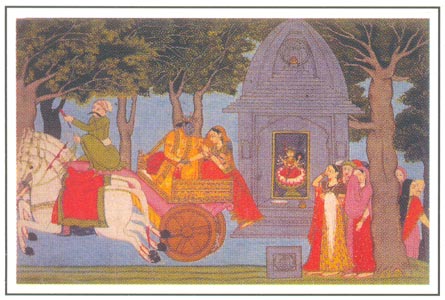 |
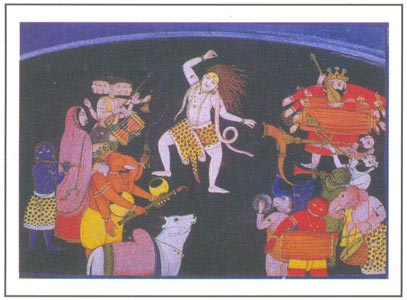 |
|
Elopement of Rukmini, Chamba, circa 1800 A.D., National Museum, New Delhi |
Shiva Dancing, Chamba, circa 1780-90, National Museum, New Delhi |
Mandi, with a stylistic idiosyncrasy of its own and a greater thematic thrust, acquired a great distinction in Devi's Tantrika cult. Various tantrika innovations of Devi, usually rendered in crude awe-inspiring form, constitute the prime theme of Mandi miniatures. The awful Devi forms acquire further impetus in Mandi style by excessively and mystically used black, red and blue colours in their deepest tones.
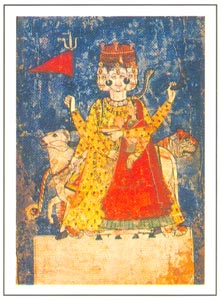 |
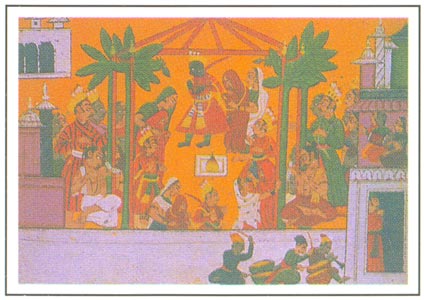 |
|
Mahakala Shiva with Parvati, Mandi, circa 1720 A.D., National Museum, New Delhi |
The marriage ceremony of Rama and Sita, Mandi, Shangri, circa 1750 A.D., National Museum, New Delhi |
Kangra represents the most glorious phase of Pahari art. There reflect in Kangra miniatures a unique sense of freedom and a closer link with the soil. They vibrate with realism, are endowed with natural emotions and their colours seem to echo with the softness of music. Use of primitive colours red, yellow and blue, fine borders, whether plain or decorative, carefully brushed jewellery, neatly laid buildings and richly relieved landscape balanced with contrasting colours and consisting of superbly treated nature trees, leaves, flowers, shrubs, birds and hills, are attributes of Kangra art. Delicately carved features of female figures delightfully portray the beauty blooming in serene quietude. A Kangra painting reveals a deeper meaning when it is contemplated in its cultural perspective and context.
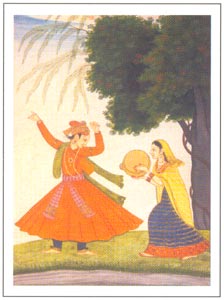 |
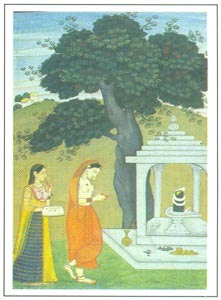 |
|
Raga Bramarananda Kangra, circa1785-90 A.D., National Museum, New Delhi |
Ragini Devagandhari, Kangra, circa 1785-90, National Museum, New Delhi |
Kangra art attained its all time heights during the reign of Raja Sansar Chand. Portraiture was the dominant art mode and the most authentic example of his court art. The portraits of this period have exceptional artistic merit and reveal great technical maturity. In vividly depicting the splendour and the glory of the court of Raja Sansar Chand these portraits are simply unique. Broadly and basically, love was the principal theme of Kangra miniatures and, hence, Rasikapriya, the great poetic work of Keshavadas, was, to Kangra artists, their chosen theme. In Radha and Krishna, they discovered not only the highest model of a loving couple or those of Nayika and Nayaka, but also various emotional and sensual situations. The Radha Krishna theme also served their devotional purpose and provided an inherent symbolism. Led by this love cult Kangra art also illustrated romances like Sassi-Punno, Heer-Ranjha, and Sohni-Mahiwal.
|
Shringara - Adornment, Kangra, circa 1800 A.D., National Museum, New Delhi |
Raja Inderdev of Bandralta worshipping Vishnu and Lakshmi, circa 1750 A.D., National Museum, New Delhi |
In subordinate Pahari art styles, Garhwal miniatures are known for the same softness of colours and delicacy of beauty as have the miniatures of Guler. Fog like tender clouds and sensitively treated nature are typical of Garhwal. Hindur or Nalagarh in Bilaspur district sought its distinction in narrative subjects and in highly evolved symbolism. Well defined faces and costumes endowed with great realism, where each figure has its own distinct features and life-style, are specialities of Hindur art.
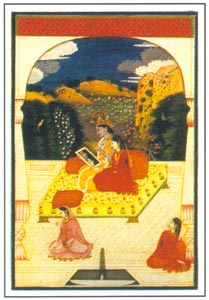 |
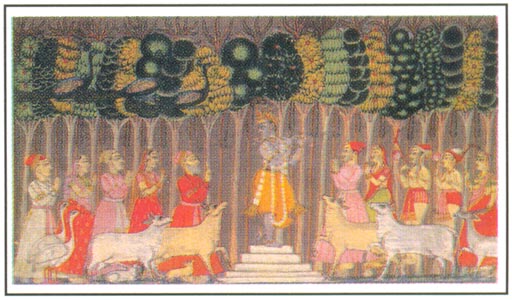 |
|
Radha and Krishna looking into a mirror, Garhwal, circa 1800 A.D., National Museum, New Delhi |
Krishna playing flute, Kullu, circa 1800 A.D., National Museum, New Delhi |
Conventional hills, strained nature, stylised human figures characterise Jammu art. The elegantly bejewelled and costumed Jammu men and women are tall and slim and have sharp features. Light colours used in brighter tones are characteristic of Jammu art style. Patiala in the Punjab plains has yet another Pahari sub-style. It is largely influenced by Sikh life-way in costumes, choice of colours, features and style of beards and moustaches. Mankot, Bilaspur, Kullu, Nurpur, Kashmir, Lahore and a few other minor centres also pursued art activities but with little distinction.
Dr. Daljeet & Dr. VK. Mathur
(Source: Gallery Sheets of Indian Miniature paintings published by the National Museum. New Delhi)
|
|